Poker Hands¶
When comparing individual card ranks, the ace is the highest card. An ace can be used as a one to make straights or straight flushes, but in that case it counts as low card. For example, a straight or straight flush 2-3-4-5-6 is higher than A-2-3-4-5. T-J-Q-K-A is the highest possible straight or straight flush.
If a hand matches multiple definitions, the strongest hand is used. For example, 2-3-4-5-6 of Hearts is a straight flush, even though it matches the definitions of straight flush, flush, straight and high card.
| Hand name | Sample hand | Tiebreaker |
|---|---|---|
| Straight Flush Five cards in sequence, all of the same suit. The highest possible straight flush (A-10) is called a royal flush. | 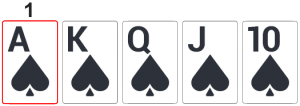 | Straight flushes are compared by the rank of their highest card (1). Note: In a 5, 4, 3, 2, A straight flush, the ace counts as a one, which makes this a 5-high straight flush, the smallest possible. |
| Four of a Kind (Quads) Four cards of the same rank and one other unmatched card | 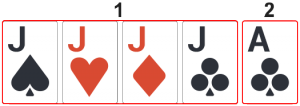 | Quads are first compared by the rank of four matched cards (1). If those are tied, the unmatched card (known as the kicker) (2) is compared. |
| Full House Three cards of the same rank and a pair of other rank | 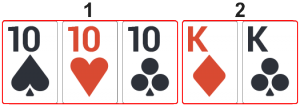 | Full houses are first compared by the rank of the triplet (1) and if they are tied, by the rank of the pair (2) |
| Flush Five cards of the same suit | 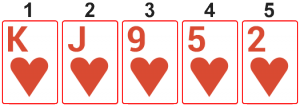 | Flushes are first compared by their highest rank (1), if that is tied – by second highest (2) and so on (3,4,5) |
| Straight Five cards in sequence |  | Straights are compared by the rank of their highest card (1). Note: In a 5, 4, 3, 2, A straight, the ace is a small card, which makes this a 5- high straight, the smallest possible. |
| Three of a Kind (Trips) Three cards of the same rank and two unmatched cards | 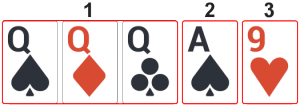 | Trips are first compared by the rank of the three matched cards (1), then by the higher one of the unmatched cards (known as the kickers) (2) and finally by the lower unmatched card (3) |
| Two Pair Two pairs of different ranks and an unmatched card | 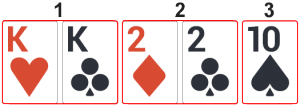 | Two pairs are first compared by the rank of the higher pair (1), then by the lower pair (2) and finally by the rank of the kicker (3) |
| Pair Two matched cards and three unmatched cards |  | Pairs are first compared by the rank of the matched cards (1), and then by the kickers (2,3,4), starting from the highest one and comparing until a difference is found |
| High Card Five unmatched cards | 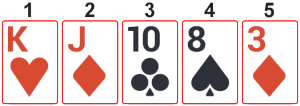 | High cards are compared by the rank of the highest card (1), and if that is the same, the next highest (2) and so on (3,4,5) |